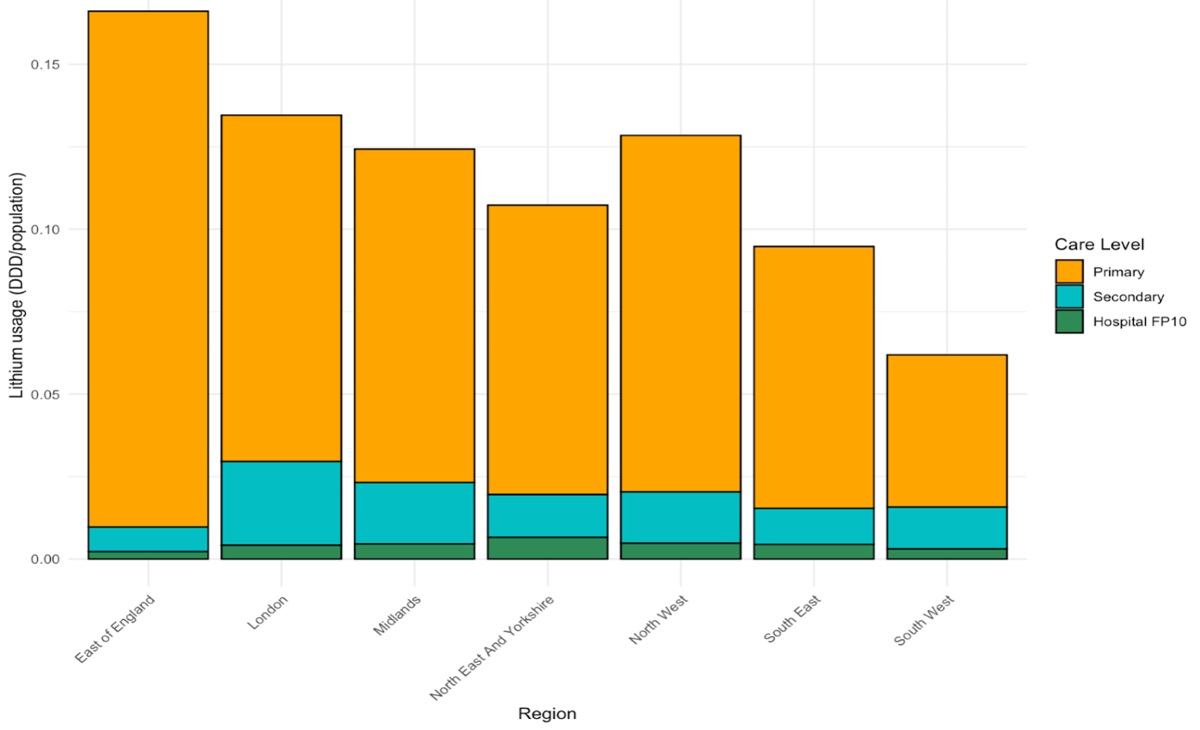Analysing lithium usage in primary and secondary care
- Posted:
- Written by:
-
- Hayley Schiffer
- Categories:

Hayley Schiffer is a student at King’s College London, studying Neuroscience and Psychology, graduating in the summer of 2026. In this guest blog, Hayley describes her work as a HDRUK health data science intern at The Bennett Institute, where she recently completed a project investigating the trends and variations in lithium usage in primary and secondary care in England.
Why look at lithium prescribing in England?
Bipolar disorder is a severe mental health disorder characterised by individuals experiencing both depressive states and hypomanic states. Bipolar UK reports that 1 in 50 people in the United Kingdom (1.3 million) have bipolar disorder. Lithium is the gold standard for the treatment and long-term prevention of relapse in bipolar disorder, as reflected in national guidelines (NICE and the BAP). However, literature suggests that lithium use is declining relative to alternative treatments. Therefore, with the support of the team at the Bennett Institute, I set out to report lithium usage in primary and secondary care in England.
Which data sources did we use?
We linked three openly available NHS medicines datasets. Each dataset is accessible via the NHS Business Services Authority Open Data Portal.
| Care Setting | Lithium use | Source |
| Primary Care | Prescribed to individuals | English Prescribing dataset |
| Secondary Care | Prescribed to individuals on FP10s and dispensed in community | Hospital FP10 |
| Issued in hospitals | Secondary Care Medicines Data (SCMD) |
We extracted products containing lithium from these data sources using British National Formulary (BNF) (for primary care and hospital FP10 data) and Virtual Therapeutic Moiety codes from the dictionary of medicines and devices (dm+d) (for the SCMD).
The codes used are shown in the table below:
| Lithium product group | BNF code | dm+d code |
| Lithium carbonate | 0402030K0 | 776555000 |
| Lithium citrate | 0402030P0 | 776556004 |
How did we count how much lithium had been used?
We reported the usage of lithium as the total number of Defined Daily Doses (DDDs). A DDD is an assumed average daily maintenance dose for a drug when used for its main indication in adults published by the World Health Organisation. The DDD for lithium is defined as 24 mmol per day. (World Health Organization Collaborating Centre for Drug Statistics Methodology, 2024).
For example:
Lithium carbonate 200mg modified-release tablets
1 tablet = 200mg = 5.4 mmol (mmol)
100 tablets = 540mmol (total mmol)
540mmol / 24 mmol (total mmol / DDD) =22.5 DDDs
To review or reuse these calculations and see how we approached lithium citrate all code is openly available in this Github repository.
How did we approach regional breakdowns of lithium use?
We broke down our results into the seven NHS regions. To compare regional usage, we reported usage of lithium per capita using population estimates from the Office for National Statistics.
What did we find?
Lithium usage has decreased nationally by 4.14% between 2019-2024, despite guideline recommendations.
- The majority of lithium is prescribed in primary care and primary care lithium prescribing has decreased by 6.33%.
- There has been a slight rise in hospital prescribing (Secondary care, +6.77% and FP10, +15.18%.)

- There is large regional variation.
- In primary care, the highest prescribing rates were seen in the East of England, followed by the North West, London, and the Midlands. In secondary care, London had the highest rate, with the East of England showing the lowest.

Things I’ve learned:
Throughout my time at the Bennett Institute my programming skills have been stretched! For example, I have become more familiar with other programming languages such as Python through practical use and application (pulling data from BigQuery and using Jupyter notebooks). My skills have improved in spatial data analysis as I have engaged with various new techniques in visual data analysis. For example adapting mapping code and plotting using shapefiles in R. These were both novel concepts introduced to me by my supervisor during our weekly lithium catch-up meetings. My ability to interrogate large and unfamiliar datasets has been encouraged by the innovative platform that is Open Prescribing Hospitals! All of my code is openly available for inspection and reuse by anyone on Github.
Next steps:
This is a work in progress. I am currently still collaborating with the Bennett Institute on writing up my findings. If anyone is interested in this work, please feel free to contact me and the team : bennett@phc.ox.ac.uk


